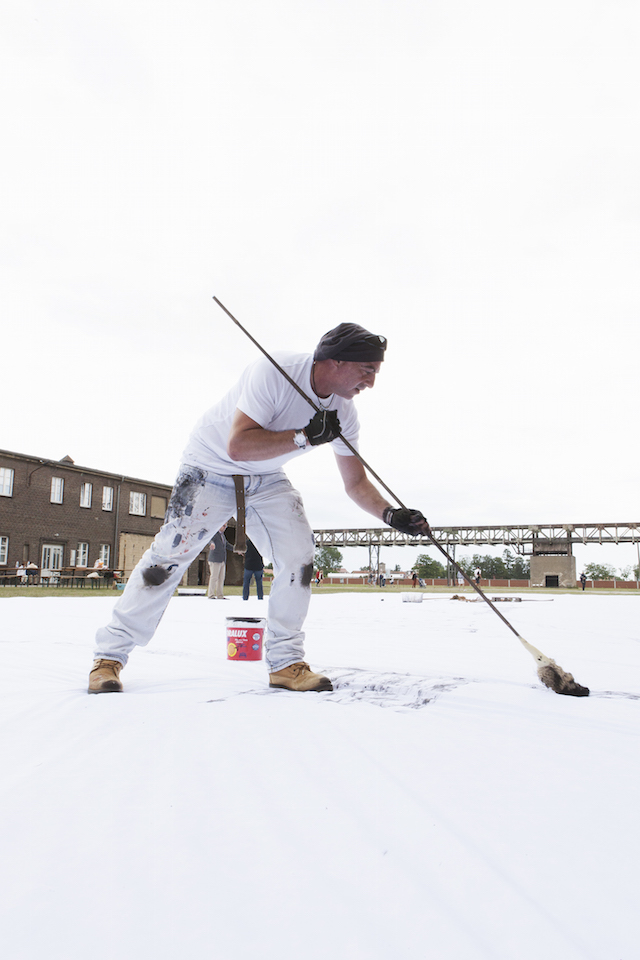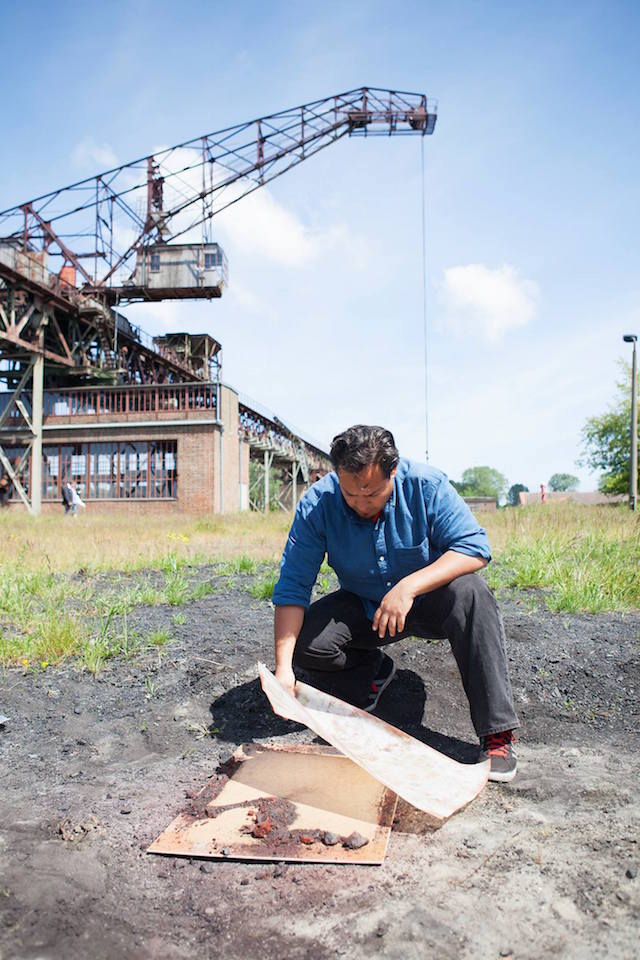IMPRINTING HISTORY 2015/2016
Von Juli bis Oktober 2015 bemalte der katalanische Künstler Gregorio Iglesias Mayo eine Leinwand in der Größe von ca. 37x12m auf dem Innenhof des Museums. Auf und unter der Leinwand hat er Schutt, Ruinen und Metallstücke verteilt, die im wahrsten Sinne des Wortes das Bild prägen. Auch das Wetter und der Boden haben sich auf der Leinwand abgebildet und haben so einen direkten, authentischen Bezug zum Ort und zu seiner Geschichte hergestellt. Der Künstler will in seinem Werk die Geschichte des Ortes, seine weltweite Bedeutung und sein heutiges Aussehen einfangen. Die Besucher konnten ihm tagtäglich bei der Arbeit zusehen und sich mit seinem Blick auf Peenemünde unmittelbar auseinandersetzen.
Parallel zu Gregorio Iglesias Mayo beschäftigte sich der Druckgrafiker Prof. Miguel A. Aragón (Mexiko/USA) ebenfalls mit dem Abdruck der Geschichte in Peenemünde. Er legte Blätter auf dem Gelände aus, die mit lichtempfindlicher Flüssigkeit präpariert sind, sogenannte Blaudrucke. Sie reagieren dann ähnlich wie ein Foto, nur viel langsamer, auf Licht, fangen also Himmel, Erde und die Relikte der Peenemünder Geschichte ein.
Prozesse beider Künstler kreieren ein Bild in zeitintensiven Verfahren, durch Einbrennen oder durch Abdruck, wobei sie Materialien benutzen, die spezifisch sind für diesen Ort. Das langsame Verblassen eines Bildes wiederum ist eine künstlerische Auseinandersetzung mit der Erinnerung.
Das Projekt ist eine Kooperation mit dem Till Richter Museum für Zeitgenössische Kunst, Schloss Buggenhagen, wo die Künstler während ihres Aufenthalts wohnen und arbeiten. In beiden Museen werden die Werke der Künstler ausgestellt. Das Gemälde im Riesenformat von Gregorio Iglesias Mayo, eine raumgreifende Installation von Miguel A. Aragón sowie eine Fotodokumentation der katalanischen Fotografin Gala Oró werden in der Turbinenhalle des Kraftwerks Peenemünde von Mai 2016 bis Oktober 2017 ausgestellt sein.
A Painting of 37 x 12m (122 x 40ft) is created for the HTM Peenemünde
From July through October 2015 the Catalonian artist Gregorio Iglesias Mayo paints on a giant canvas laid out in the courtyard of the museum. He scatters rubble, ruins and metal relics on top of and under the canvas. They literally inform the work, as do the weather and the soil from above and from below. This provides for a direct and authentic connection to the site and its history. The artist strives to capture the history of this place, its worldwide significance and its current day appearance. Visitors can watch him work on a daily basis and are confronted immediately with his view of Peenemünde, which may in turn inform their own view.
At the same time printmaker Prof. Miguel A. Aragón (Mexico/USA) also takes on the imprint of the history of Peenemünde. On the grounds of the museum he distributes sheets of paper that are coated with a light-sensitive emulsion, a process called cyanotypes. They react similarly to light as photo paper just much slower. He also uses dust, earth and rust to create negatives that are then imprinted onto the sheets. In this way the artist captures the earth, the sky and the history of the site. Both artists’ processes have to do with the creation of an image through a time consuming process where the image is burned or imprinted into a formerly blank medium while using site-specific materials. The fading of the image or decay of the materials in turn relate to the fading of memory.
The project is a cooperation with the Till Richter Museum for Contemporary Art at Buggenhagen Castle, where the artists live and work for the duration of the project. The giant painting, a large installation by Miguel A. Aragón as well as the documentation by the Catalan photographer Gala Oró will be exhibited in the Turbine Hall of the power plant Peenemünde from May 2016 to August 2017.
Gregorio Iglesias Mayo
Artist Statement
Manchmal habe ich gesagt, dass ich zwischen zwei Familien geboren sei, zwischen zwei Flaggen und zwei Blutlinien, ohne Möglichkeit von einer eigenen Identität zu profitieren. „Passiert das auch in der Kunst?“, diese Frage stellen sich die Experten.
Eine Zeit lang lebte ich in Paris. Wo sonst?! Mit dem Ziel all’ das zärtlich zu erfassen, was sich nicht zärtlich erfassen lässt. Während meiner Ausstellung im Zentrum für Katalanische Studien der Sorbonne lernte ich Till Richter kennen. Jemand der mich, mehr als einmal, sehr positiv beeinflusst hat in meinem Leben, indem er mir geholfen hat Kunst zu schaffen und zu leben, zwei Dinge, die für mich zusammengehören wie die zwei Seiten einer Münze.
Jahre später habe ich erfahren, dass Till in seine Heimat zurückgekehrt ist, um dort in Buggenhagen das Till Richter Museum zu gründen. In einer unserer Konversationen habe ich ihm von der Situation erzählt, die mein Land durchmacht. Und wenn ich sage mein Land, dann weiß ich nicht genau, was ich damit meine.
Krise. Wirtschaftlich, menschlich, sozial. Was uns dazu bringt immer wieder dieselben Fehler, Enttäuschungen und Täuschungen zu begehen. Ich habe fast meine Identität verloren, das was für mich meine Ursprünge bedeuten. So fühlte ich die Notwendigkeit zu reisen, zu sehen, zu hören. Nachdenken, fühlen und den Sinn finden warum ich tue, was ich tue…
In Buggenhagen erzählte mir Till von Peenemünde; und ich ging hin. Dort wo es auch ein Konzentrationslager gab, versehen mit Nachforschung, Kreation, Intelligenz, Schwäche, Gegensätzen, Frustration, Ohnmacht und Kampf um das Notwendigste, hat es sich für mich in einen spirituellen Ort verwandelt, der Anfang meines Friedens und Verstehens: Es ist das Wissen, das uns frei machen wird. Es wurde mir klar, dass das Ziel der Reise die Reise selbst ist.
Ich fand es notwendig Peenemünde zu berühren: Die Steine, das Eisen, das Holz, die Erde, den Regen, seine Hitze und Kälte, seine Geschichte, das Vergehen der Zeit.
So bin ich raus aus dem Atelier und rein in die Geschichte. Meine Art der Geschichte zu folgen war diese große Leinwand hinzulegen, damit die Gegenstände, die Natur, das Wetter und der Zahn der Zeit sie bearbeiten. Die Geschichte und ich wir waren dabei das zu schreiben, was jetzt in ihr (der Leinwand) war. Die Kunst ist der Mensch, der der Natur hinzugefügt wird …
Ich habe versucht, die Geschichte in dieses Bild zu prägen. Ich habe, während ich „im Bilde“ war, oft in den Himmel gesehen, und ich bin ganz sicher, dass jemand oder etwas mir geholfen hat.
Ich bedanke mich für die Menschlichkeit, das warme Willkommen, die Zusammenarbeit und Hilfe von all denen die Peenemünde leiten und dort arbeiten. DANKE, dass sie Teil meiner Reise sind.
Sometimes I’ve said that I am born in between two families, two flags and two blood lines, without the possibility to have my own identity. „Does that happen in art, too?“ is a question experts wonder about.
At a certain time I lived in Paris. Where else?! My goal was to tenderly grasp all those things that refuse to be tenderly grasped. During my exhibit at the Center for Catalonian Studies of the Sorbonne I got to know Till Richter. Someone who, more than once, influenced me in a very positive way by helping me to create art to and to live, two things that for me are two sides of the same coin.
Years later I learned that Till had come back to his homeland in order to found the Till Richter Museum in Buggenhagen. In one of our conversations I told him of the situation my country was suffering from. And when I say ‚my country‘ I’m not exactly sure what I mean.
Crisis. Economical, human, social. Whatever lets us commit the same errors, deceits and betrayals over and over again. I had almost lost my identity, that what for me means the origin of who I am. Thus I felt the urge to travel, to watch and to listen. Reflect, feel and find a sense in why I do what I do.
In Buggenhagen Till told me of Peenemünde; and I went there. The place where once there had also been a concentration camp, a place of research, creation, intelligence, weakness, contrasts, frustration, helplessness and the fight for the most rudimentary things; this place transformed for me into a spiritual place, the beginning of my peace and understanding: It is the knowledge that will set us free. It became clear that the goal of the voyage is the voyage itself.
I found it necessary to touch Peenemünde: the stones, the iron, the wood, the earth, the rain, its heat and cold, its history and the passing of time.
So I got out of the studio and into history. My way of following history was to lay down this big canvas, so that the things, the nature, the weather and the tooth of time could go to work on it. History and I we were about to write what is now in and on it (the canvas). Art ist man added to nature.
I have tried to imprint this picture with history. I have, while being ‚in the picture‘, often looked at the sky and I am very certain that someone or something has helped me.
I want to say thanks for the humanness, the warm welcome, the cooperation and help from all those who direct the institution at Peenemünde and who work there. THANKS for being part of my voyage.
Miguel A. Aragón
Artist Statement
Das Historisch-Technische Museum Peenemünde ist ein von der Geschichte aufgeladener Ort, der die menschliche Existenz verändert hat. Es ist ein Ort, der nur wegen seines Potentials geschaffen worden ist, was bis zum Ende des Zweiten Weltkriegs nie erreicht wurde. Das unablässige Streben das Unmögliche trotz immerwährende Versagens zu realisieren zieht mich an.
Als Künstler kann ich die Idee gut nachvollziehen, ein Ziel anzustreben, das nur auf Potential beruht. Es gibt keinen konkreten Beweis, dass mein Werk funktionieren wird; und auf dem Weg gibt es viele Fehler und Missgeschicke. Trotzdem, ich muss das überwinden, weil ich Zuversicht habe.
Mit Sonnenlicht als Hauptelement schaffe ich Werke in der Technik der Cyanotypie, auch Blaudruck genannt. Diese Drucke benutzen Sonnenlicht, um ein vorher mit lichtempfindlicher Flüssigkeit imprägniertes Papier mit Motiven zu belichten. Dazu stelle ich eine Serie von Bildern auf transparenter Folie her, wie ein Negativ, und zwar mit Teilen aus den vor Ort existierenden Anlagen und Gebäuden: Rost, Staub, Kohle und Sand. Das alles sind Produkte von Zerfall, Erosion und Altern. Auf diese Art halte ich Geschichte fest, die bereits den Elementen anheimgestellt ist und von ihnen erodiert wird. Ich transferiere die Geschichte in einen haltbareren Zustand.
Dieses Projekt ist Teil meiner fortwährenden Erforschung, wie man einen spezifischen Moment festhalten und einfrieren kann; die Zeichen der Zeit, sie drücken die vergängliche Nature der Erinnerung aus, reflektieren den Prozess des Sammelns von Erinnerungen. Ein verblassendes Gedächtnis das die Vergänglichkeit der menschlichen Existenz spiegelt.
Darstellungen des Sichtbaren werden immer auch Reste und Spuren des Unsichtbaren aufweisen. Die Bilder, die ich mache, verbinden die Welten dessen, was sichtbar ist und dessen, was man nur intuitiv wahrnehmen kann.
The Historisch-Technisches Museum Peenemünde is a place charged with history, which altered human existence. It is a place that was built solely on the fact of its potential, which would never be fully reached until after the end of the Second World War. I am attracted to this relentless drive to realize the impossible despite the constant failures.
As an artist I relate to this idea of pursuing a goal that is only based on potential, no concrete evidence exist that my work will function, and along the way many mistakes and failures are encountered; however, I must push through all of these because I have a belief.
Utilizing sunlight as the main element, I am creating a body of work through the Cyanotype technique. These pieces use sunlight to expose pre-coated light sensitive paper recording and leaving the imprint of an image as the sun exposes the emulsion. To do this I am creating a series of images on transparent film, like a negative, utilizing elements taken from the installations, such as rust, dust and coal. These are all products of decay, erosion and ageing. In this way I am capturing the history already possessed and eroded by the elements and translating them into a more permanent state.
This project is part of my continued exploration of trying to capture and freeze a specific moment, the marks of time, conveying the transitory nature of memory, reflecting on the process of recollection, fading memory and alluding to the transitory nature of human existence.
Representations of the visible will always show residues and traces of the invisible. The images I create connect the spheres of what can be seen and what can be only intuited.
Weitere Infos auf der Webseite des Historisch Technischen Museum Peenemünde – hier klicken.
Copyright Projekt Peenemünde ©2015 Till Richter Museum und Historisch-Technisches Museum. Alle Rechte vorbehalten.
Copyright Fotos ©2015 Gala Oró
Copyright Text ©2015 Dr. Philipp Aumann und Dr. Till F. A. Richter








